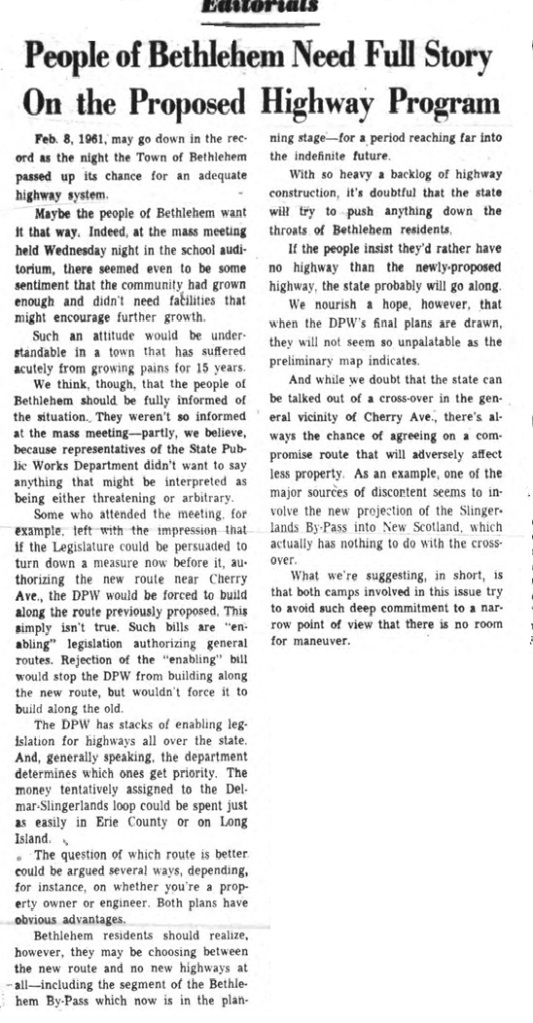February 1961
In the first few months of 1961 Governor Rockefeller’s proposal to re-invent the Capital City was met, for the most part, with open arms and enthusiasm. (At least by community leaders, downtown merchants, local newspapers and suburbanites.) But there was one notable, and illustrative, exception.
One of the key plans in the works prior to Rocky’s announcement of the “NEW” Albany was the development of a series of arterials and “by-passes” surrounding Albany; to make travel in and out of the City easier. Planning of a Riverfront Arterial (787) was well underway, and work was expected to start shortly. However, the Delmar/Slingerlands Bypass was still in the planning phase. The Slingerlands component of the Bypass would start at the State Campus, between Western and Washington Avenue with the construction of the Crosstown Arterial. The Delmar component would be linked into the Riverfront Arterial (787), and skirt the City on the south. The two “bypasses” would join up in a largely undeveloped area in the Town of New Scotland.
That was the plan until a new, “flatter” route was proposed. This new route would avoid valleys and hills, and cut through high density residential areas of Delmar, linking to the Slingerlands portion in the vicinity of Bridge Street and Cherry, Kenwood and Union Avenues. The Delmar and Slingerlands areas were, coincidently, home to many high ranking officials in Rocky’s Administration. When the new proposal was revealed, many of the good people of Bethlehem – including those identified as “prominent area residents” in the local newspaper – went nuts.
Petitions were signed, 700 residents showed up at a protest meeting, and letters sent to local newspapers, elected representatives, Administration officials and, of course, to the Governor.
State Senator Julian Erway and Assemblymen Harvey Lifset, who represented the area, were moved to issue a statement saying they would ““talk to engineers about the routes and oppose any legislation unnecessarily threatening communities way of life”. Further, they added, ” Any highway bill introduced in the future will have our close scrutiny as it effects these communities and every effort possible will be exert on our part to defeat any measure that would unnecessarily disrupt the quiet enjoyment of its homes and neighborhood living.”
The communities’ message was clear. Don’t mess with us. We do not want your highways. And it was received as clearly. The residents of the suburbs won. It was all over in a matter of a less than a month..
Bits and pieces of the Bypasses were constructed over a period of 50 years, but the original proposal died. It was moribund by 1963 and never revived.
Construction on the Albany section of the Slingerlands Bypass began in the early 1962. This first section, the Crosstown Arterial, from Washington on Avenue to Buckingham Drive in Albany was completed by 1964.. Another 2 lane highway section, not 4 lane as originally proposed, linking the Bypass to New Scotland Road was completed in 1968. A final 4 lane section of the Bypass was completed in 2005, but it too ends at New Scotland Road.
The 4 lane section of the Delmar Bypass (Rte. 32) that links to the Riverfront Arterial (787) via Southern Boulevard was constructed, but it ends at Elm Avenue on the outskirts of Delmar. You can get to the Slingerlands Bypass by traveling over 2 lane Elm Avenue; a meandering circuitous route, not nearly a straight shot as originally envisioned.
My takeaway is that the “prominent” residents of the suburbs pushed back hard enough against New York State and did not have its will imposed on them.
That didn’t happen in the area where the South Mall was built. To the extent those residents spoke out, their voices were not heard.
February 2 1961
February 7, 1961
 February 7, 1961
February 7, 1961
February 10, 1961
February 10 , 1961
February 13, 1961
February 15, 1961
February 16, 1961
February 16, 1961
February 21, 1961
And that was it. Oh, there were a couple more minor skirmishes, but the community had won.
February 27 1961
February 28, 1963
February 28, 1961














